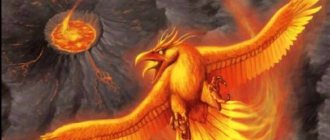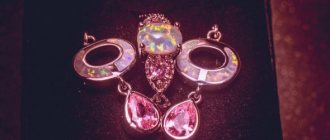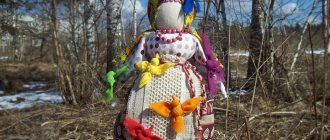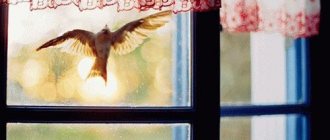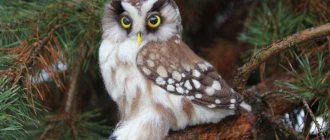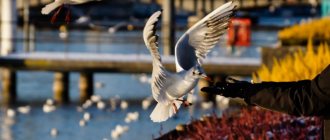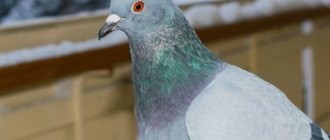Varieties of phoenix figurines
- With wings down
- With wings spread
Both of them have the same properties: they symbolize wisdom, prosperity and success. The energy of the phoenix allows one to be reborn from the ashes, and the bird itself is a symbol of divine fire, the flame of rebirth.
- There is also a double figurine: a phoenix and a dragon. The combination of these powerful magical creatures is a symbol of a harmonious marriage, where the phoenix personifies the feminine principle, and the dragon represents the masculine. These figurines are used during wedding ceremonies.
Phoenix crafting material
A phoenix figurine can be bronze, sometimes Chinese craftsmen carve a phoenix on jade, but most likely you can buy this symbol made of a synthetic material, for example, polystone - artificial stone or plaster. This phoenix is even preferable, since its wings are easier to paint red.
Phoenix figurines are quite rare, so some Feng Shui experts suggest the possibility of replacing it with another bird with bright plumage, such as a rooster or, in rare cases, a flamingo.
Magpie according to Feng Shui
The magpie is revered in Feng Shui and Chinese mythology due to the similarity of the sound of the hieroglyph that describes this bird and the hieroglyph for “happiness.”
That is why a pair of magpies sitting on the branches brings double luck in any business. It is useful to use this symbol in the living room, in the Central sector, which is responsible for the overall harmony in the home.
Any talisman with the image of a bird, especially one soaring in the air, will bring harmony and lightness to the house.
Related article: Aged furniture: how not to make the interior “old”
TALISMAN PHOENIX BIRD. SYMBOL OF PROSPERITY WELFARE AND GOOD LUCK (1 video)
Birds according to Feng Shui (9 photos)
The best posts
- Crochet flower patterns - violets poppies roses calla lilies
- Technical characteristics of types of blinds
- 6 nuances for using blue in the interior of a children's room
- How and which circular saw is best to choose for different tasks?
- Concrete for the pool bowl: which one to use and how to mix
- How to remove radio components from a board with your own hands
- Grout for tile joints in the bathroom: which one is better?
- Color palette for interior decoration (+50 photos)
Location of the figurine
Since the phoenix represents the element of fire, it should be placed in the south. It is very good if there is a fireplace or hearth in the southern part of the house. This is the best place for a firebird. If there is no fireplace, you need to light a candle next to the figurine or illuminate it with a lamp. In this way, the talisman is activated and the energy is directed in the right direction.
The Phoenix is placed in the sector of fame and fortune; it brings prosperity to the home, success in all matters and endeavors, and gives inspiration for creativity. This royal bird needs space; there should be no foreign objects, figures or decorations around it. You cannot place a phoenix in the bedroom, as it gives too much energy and sleep will be restless.
You can also use the phoenix figurine together with other magical animals of the heavenly four, which are the best guardians of the house.
In this case, you can place all four figurines in the hallway area as follows: a turtle is placed outside in front of the front door, a tiger is placed in the hallway to the right of the door, a dragon is placed on the left, and a phoenix is placed opposite the front door. This arrangement maximizes the protection of the house and harmonizes the interior space. Alexander, November 8, 2014.
Category: Phoenixes and dragons
dragon Buddhism came to China from India almost two millennia ago. As Buddhism spread in China, it adapted to Chinese culture. The monks stopped wearing traditional saffron robes and switched to Chinese-style clothing. And in China, Buddhism met dragons.
Dragons have been a part of Chinese culture for at least 7,000 years. In China, dragons have long symbolized strength, creativity, heaven and good fortune. They are believed to have power over bodies of water, rain, floods and storms.
Over time, Chinese Buddhist artists adopted the dragon as a symbol of enlightenment. Today, dragons adorn the roofs and gates of temples as guardians and symbolize strength and enlightenment. Dragons in Chan (Zen) literature In the 6th century, Chan (Zen) appeared in China as a special school of Buddhism. Chan was raised in Chinese culture, and dragons appear frequently in Chan literature. The dragon plays many roles - as a symbol of enlightenment, but also as a symbol for ourselves. For example, “meeting the dragon in a cave” is a metaphor for confronting your deepest fears and obstacles.
And then there is the Chinese folk tale of the "true dragon", adopted as a parable by countless teachers. Here's the story: Yeh Kung-tzu was a man who loved dragons. He studied dragons and decorated his home with paintings and statues of dragons. He loved to talk about dragons to anyone who would listen.
One day the dragon heard about Ye Kung-tzu and thought how wonderful it was that this man valued us. This would surely make him happy to meet a real dragon. The good dragon flew to Ye Kung Tzu's house and went inside and found Ye Kung Tzu sleeping. Ye Kung Tzu then awoke to find the dragon curled up by his bed, its scales and teeth glinting in the moonlight. Ye Kung-tzu screamed in horror. Before the dragon could introduce himself, Ye Kung-tzu grabbed the sword and rushed at the dragon. The dragon flew away. Many generations of Chan and Zen teachers, including Dogen, mentioned the real story of dragons in their teachings. For example, Dogen wrote in Funkanzazengi: “I beseech you, noble friends who learn from experience, not to become so accustomed to images that you are alarmed by a real dragon.”
As an allegory, the story can be interpreted in many ways. This could be an allegory for someone who has an intellectual interest in Buddhism and reads many books about it, but who does not feel the need to practice, seek a teacher, or take refuge. Such a person prefers something like artificial Buddhism to real Buddhism. Or it could mean a fear of letting go of the ego in order to achieve enlightenment.
Nagas and Dragons
Nagas in the Vedas and myths of ancient India In the Vedas and myths of Ancient India, the sage Kashyapa, the grandson of the creator of the world Brahma, is recognized as the progenitor of most living beings. From his three eldest wives he gave birth to demons-asuras and gods, and the other ten wives [1] gave birth to various creatures that inhabited the earth, the skies, and the underworlds. Surasa gave birth to huge monstrous dragons, Arishta became the ancestor of crows and owls, hawks and kites, parrots and other birds, Vinata gave birth to the giant sun birds suparnas, Surabhi - cows and horses, and many more divine and demonic creatures descended from other wives of Kashyapa, daughters of Daksha . Kadru became the mother of the nagas, and Muni became the mother of the crafty geniuses of the Gandharvas, who settled in the heavens along with the “nymphs”-apsaras.
The Nagas, the children of Kashyapa and Kadru, gigantic snakes, settled in the underworld of Patala[2], where they erected for themselves magnificent palaces, shining with gold and precious stones. The wise serpent Vasuki became the king of the nagas and ruled in their underground city of Bhogavati, full of treasures unprecedented on earth. Some of the nagas settled in underground waters, in rivers and at the bottom of the ocean, in the kingdom of the god Varuna. Snakes also live on the surface of the earth, where they guard treasures and treasures. Royal snakes, three-headed, seven-headed and ten-headed, possess untold wealth; their heads are crowned with precious crowns; they are powerful and wise; leaders of the great Naga tribe, they gained the favor and friendship of the gods.
Once upon a time, the nagas[3] in their underground kingdom were attacked by their relatives, the Gandharvas, led by their king Visvavasu. The Gandharvas defeated the snakes and took away their jewelry and treasures. The nagas then resorted to the protection of the great god Vishnu. He descended into the underworld, expelled the Gandharvas from there and forced them to return the loot to the nagas. The thousand-headed universal serpent Shesha, also called Ananta, the Infinite, brother of King Vasuki, the largest of the serpents, became the friend and companion of Vishnu; floating on the surface of the universal waters, it has since served as a support and bed for Vishnu, when the great god rests and sleeps.
Both nagas and gandharvas could change their appearance at will, and often both appeared among people in human form. Often, earthly kings and heroes took naginis as wives - maidens of incomparable beauty who were snakes by birth.
[1] In various texts of the epic, the genealogy of mythical creatures and animals descended from Kashyapa’s wives diverges greatly and there is no generally accepted genealogy (just as there is no single list of names of Kashyapa’s wives). Usually in all versions Vinata is the mother of the suparna birds and Kadru is the mother of the naga snakes. Regarding the offspring of Kashyapa's other wives, we observe considerable discrepancy in the epic texts. Arishta is called either the mother of some birds or the mother of Gandharvas, Kapnla - cows, but also Gandharvas and Apsaras, Muni - Gandharvas, but in other texts - Apsaras (another version of the origin of Apsaras is given below). In addition, various epic and puranic texts mention Simhika - the mother of Rahu and other eclipse demons, Danaya - the mother of Vritra and other dragons, Krodha - the mother of wrath demons, and many others.
[2] Patala is the general name for the seven underground regions inhabited by nagas and demons.
[3] This is described in the book. III Vishnu Puranas. https://rushist.com/index.php/mifologiya/6582-nagi-v-vedakh-i-indijskoj-mifologii
Buddha with Naga Nagas are serpentine creatures that appear in the Pali Canon. They are sometimes identified as dragons, but have slightly different origins.
Phaya Naga Temple Wat Si Saket Naga is the Sanskrit word for cobra. In ancient Indian art, nagas are depicted as people from the waist up and snakes from the waist down. They also sometimes appear as giant cobras. In Hindu and Buddhist literature they can change appearance from a human to a snake.
Nagas and Garuda in the Mahabharata In the Mahabharata, the story of the nagas and Garuda, the nagas are depicted as primarily evil beings bent on harming others. In the poem, the enemy of the nagas is the great eagle king Garuda.
In the Pali Canon, the nagas are treated more sympathetically, but they are forever at war with the garudas, except for a brief truce negotiated by the Buddha. Over time, nagas began to be depicted as the guardians of Mount Meru, as well as Buddha. Nagas play an important role in Mahayana mythology as protectors of sutras. You may find images of Buddha or other sages sitting under the canopy of a large cobra; it will be naga.
When Buddhism spread to China, and then to Japan and Korea, the nagas began to be considered a kind of dragons. Some stories told in China and Japan about dragons originated as stories about nagas.
However, in Tibetan Buddhist mythology, dragons and nagas are completely different creatures. In Tibet, nagas are usually disgusting water spirits that cause illness and misfortune. But Tibetan dragons are the protectors of Buddhism, whose thunderous voices awaken us from delusion.
Dragon in Tibetan Buddhist symbolism
Dragon with a flaming pearl
Unlike its demonic European counterpart, the Tibetan dragon is a creation of great creative power, a positive sign representing strong masculine yang, energy changes, wealth and creativity. Dragons are shapeshifters who can transform at will, from as small as a silkworm to a giant that fills the entire sky. Dragons are depicted in one of two colors: green or brown. The green or azure dragon from Buddhism rises into the sky at the spring equinox, it represents the increasing strength of light in springtime and the eastern direction of sunrise. The brown dragon is the autumn equinox when it descends into a deep pool, covering itself with mud until next spring, but its spirit is still with the practitioner, bringing wealth and health. Pearls or precious stones held in the dragon's claws contain wisdom and health. The dragon can control the weather by squeezing the jewels to produce dew, rain, or even showers when they are squeezed tightly.
